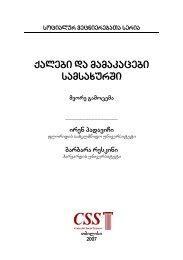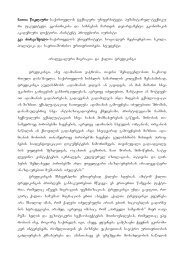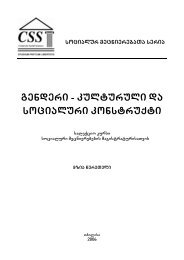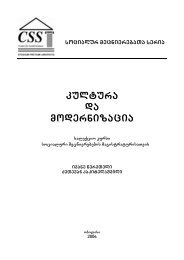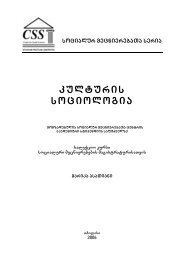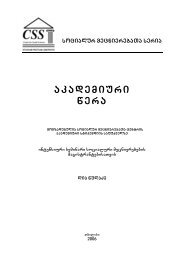Tvisebrivi meTodebi socialur kvlevaSi - Center for Social Sciences
Tvisebrivi meTodebi socialur kvlevaSi - Center for Social Sciences
Tvisebrivi meTodebi socialur kvlevaSi - Center for Social Sciences
Create successful ePaper yourself
Turn your PDF publications into a flip-book with our unique Google optimized e-Paper software.
Week 6.<br />
Case Study<br />
Lecture, 3 hours; discussion, 1 hour<br />
Case study is the final method considered in terms of this course. As in the case of<br />
participant observation, we will discuss this method during two week.<br />
First we will focus on the history of this method, which was introduced in the social<br />
sciences based on the experience of anthropologists. Experience of the Chicago School and<br />
their role in establishing this method are also discussed.<br />
Case studies are a lot in common with participant observation, but we consider the<br />
<strong>for</strong>mer as an even broader research approach, rather than a single method of collecting the<br />
data. As a multi-method approach, case studies employ a number of research techniques<br />
that help the researchers to collect the data; what is particularly specific with case studies,<br />
the methods used can be both qualitative and quantitative (e.g., surveys).<br />
As an example of early case study research, we will discuss a study of the 1930s<br />
conducted by Paul Lazarsfeld and his colleagues in the Austrian village of Marienthal. This<br />
study is very interesting <strong>for</strong> us mainly from the methodological perspective, use of many<br />
various techniques of data collection which are discussed in detail by the authors.<br />
Since there is no single way to conduct case study research, and there are no clear<br />
guidelines regarding site selection and data analysis, one of the best ways to learn about<br />
this method is to introduce more examples. So, the second study we will discuss in detail in<br />
this class is Mitchel Dunier’s Sidewalk, which is distinctive in a number of ways. We discuss<br />
several aspects of this study: the research question and how it was <strong>for</strong>mulated; its<br />
theoretical context and how Dunier fit his study into the particular one; methodology used by<br />
Dunier and, specifically, his relationships with the in<strong>for</strong>mants; use of photography in<br />
presenting the findings.<br />
Required readings <strong>for</strong> this week are:<br />
Mitchel Dunier. 2001. Sidewalk. New York: Farrar, Strauss and Giroux. Pp. 17-42, 231-<br />
289.<br />
James P. Spradley. 1979. The Ethnographic Interview. New York: Holt, Rinehart and<br />
Winston. Pp. 25-39 (“In<strong>for</strong>mants”).<br />
Recommended readings:<br />
Robert K. Yin. 2002. Applications of Case Study Research. Second edition. Sage<br />
Publications.<br />
James P. Spradley. 1979. The Ethnographic Interview. New York: Holt, Rinehart and<br />
Winston. Pp. 55-68 (“Interviewing an In<strong>for</strong>mant”).<br />
Week 7.<br />
Case Study (continued)<br />
Discussion, 2 hours; students’ presentations, 2 hours<br />
This week is focused on discussions. During the class, we will first discuss readings<br />
from the Sidewalk, focusing on the specific ways of conducting fieldwork and building<br />
relationships with in<strong>for</strong>mants.<br />
In the second part of the class, the students will present their research projects focusing<br />
on (a) their research questions; (b) sites; and (c) methodology they use to conduct the<br />
fieldwork. This will be our final discussion of students’ research projects be<strong>for</strong>e they finish<br />
and submit them.<br />
109



